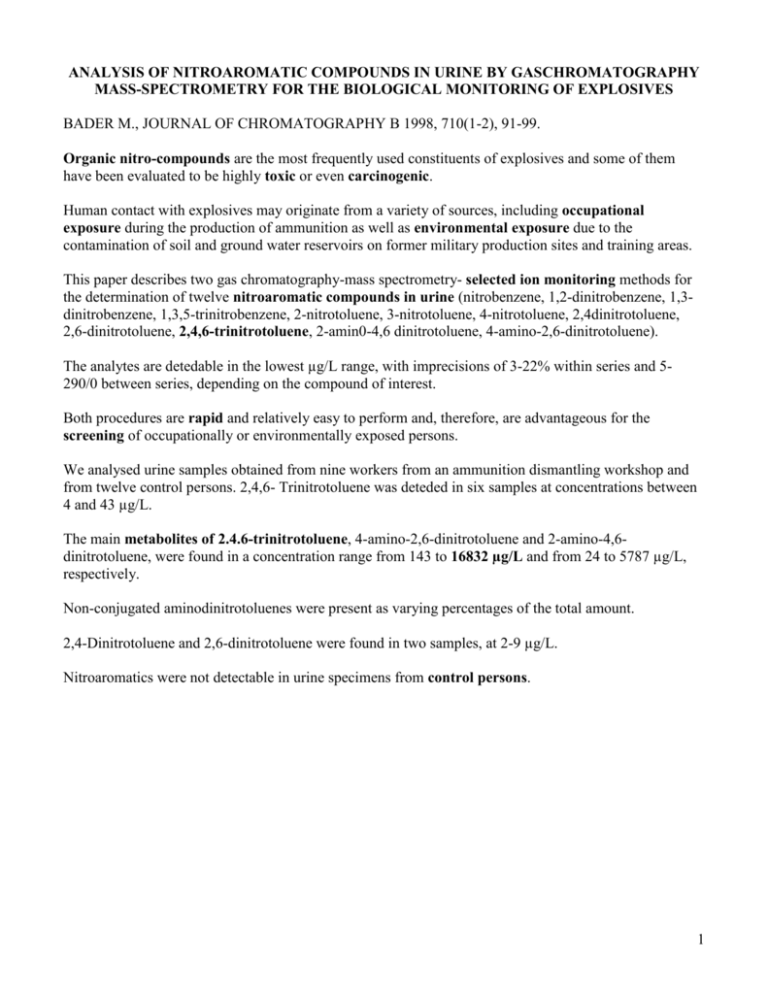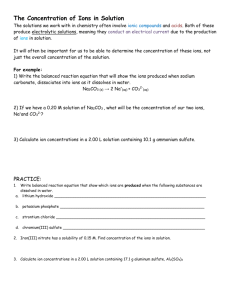2006 11 20 GC-MS (Ion trap + Quadrupole)
advertisement

ANALYSIS OF NITROAROMATIC COMPOUNDS IN URINE BY GASCHROMATOGRAPHY MASS-SPECTROMETRY FOR THE BIOLOGICAL MONITORING OF EXPLOSIVES BADER M., JOURNAL OF CHROMATOGRAPHY B 1998, 710(1-2), 91-99. Organic nitro-compounds are the most frequently used constituents of explosives and some of them have been evaluated to be highly toxic or even carcinogenic. Human contact with explosives may originate from a variety of sources, including occupational exposure during the production of ammunition as well as environmental exposure due to the contamination of soil and ground water reservoirs on former military production sites and training areas. This paper describes two gas chromatography-mass spectrometry- selected ion monitoring methods for the determination of twelve nitroaromatic compounds in urine (nitrobenzene, 1,2-dinitrobenzene, 1,3dinitrobenzene, 1,3,5-trinitrobenzene, 2-nitrotoluene, 3-nitrotoluene, 4-nitrotoluene, 2,4dinitrotoluene, 2,6-dinitrotoluene, 2,4,6-trinitrotoluene, 2-amin0-4,6 dinitrotoluene, 4-amino-2,6-dinitrotoluene). The analytes are detedable in the lowest µg/L range, with imprecisions of 3-22% within series and 5290/0 between series, depending on the compound of interest. Both procedures are rapid and relatively easy to perform and, therefore, are advantageous for the screening of occupationally or environmentally exposed persons. We analysed urine samples obtained from nine workers from an ammunition dismantling workshop and from twelve control persons. 2,4,6- Trinitrotoluene was deteded in six samples at concentrations between 4 and 43 µg/L. The main metabolites of 2.4.6-trinitrotoluene, 4-amino-2,6-dinitrotoluene and 2-amino-4,6dinitrotoluene, were found in a concentration range from 143 to 16832 µg/L and from 24 to 5787 µg/L, respectively. Non-conjugated aminodinitrotoluenes were present as varying percentages of the total amount. 2,4-Dinitrotoluene and 2,6-dinitrotoluene were found in two samples, at 2-9 µg/L. Nitroaromatics were not detectable in urine specimens from control persons. 1 BIOLOGICAL MONITORING OF DINITROTOLUENE BY GASCHROMATOGRAPHIC MASS-SPECTROMETRIC ANALYSIS OF 2,4-DINITROBENZOIC ACID IN HUMAN URINE ANGERER J., JOURNAL OF CHROMATOGRAPHY B 1998, 713(2), 313-322. The method of analysis described permits the determination of 2,4-dinitrobenzoic acid down to the lower µg/L range in the urine of persons exposed to dinitrotoluene. 2,4-Dinitrobenzoic acid is the main metabolite of 2,4-dinitrotoluene and technical dinitrotoluene. After acidic hydrolysis, which served to release the conjugated part of the 2,4-dinitrobenzoic acid, the analyte was selectively separated from the urine matrix via various extraction steps and then derivatized to the methyl ester. Quantitative analysis was carried out using capillary gas chromatography and mass selective detection. 3,5-Dinitrobenzoic acid was used as an internal standard. The detection limit was 1 µg/L urine. The relative standard deviations of within-series imprecision were 5-6%. The relative recoveries were 911100/0 depending on the concentration. The analytical method was used to investigate a collective consisting of 82 urine samples from persons working in the area of explosives disposal. The concentrations of 2.4-dinitrobenzoic acid determined ranged from the detection limit to 95 µg/L urine. The method allowed the quantification of low-level internal exposure to dinitrotoluene. 2 Gas/Liquid Chromatography - Mass Spectrometry combines separation efficiency of GC/LC with sensitivity and specificity of mass spectrometry. Mass spectrometer is a universal detector for gas/liquid chromatographs. Advantages of Mass Spectrometric Detector Specificity - characteristic fragmentation patterns information about M.W. and molecular structure 3 MS Ionization source Electron impact ionization Chemical ionization Mass Analyzers Single-focusing magnetic sector mass spectrometer Ultrahigh-resolution double-focusing mass spectrometer Quadrupole mass spectrometer Ion trap mass spectrometer Types of Mass Spectrometers p. 484 Harris 7th p. 518-528 Harris 6th 4 Principle of mass spectrometry o upon entering the ion source, analyte molecules are ionized by electron ionization (EI) or chemical ionization (CI) o the resulting ions are analyzed (i.e., separated) according to their mass-to-charge ratio (m/z) o the separated ions are detected by an electron multiplier that produces a proportional ion signal. 5 GC/MS identity and quantity of sub-ppm unknown components in complex samples Arson investigation for fire accelerants The presence of 2-pentanone in dichloromethane can be identified by … … mass spectral identification of the small peak shows the presence of dichloromethane as well as 2-pentanone 6 Interfacing GC with MS o incompatibility problem - GC operates at gas/atmospheric pressures; MS runs under high vacuum o presence of much carrier gas and little analyte in the GC effluent 7 Presence of much carrier gas and little analyte in the GC effluent can be improved by using enrichment devices: 8 9 10 Ion trap mass spectrometer p. 486 Harris 7th p. 531 Harris 6th Fig. 22-15 Fig. 22-15 11 12 13 o Through a heated transfer line, GC column eluate enters the mass analyzer cavity o The gate electrode periodically admits e- from the top filament into the cavity o Analyte molecules undergo electron impact ionization Organic molecule + e- = Organic molecule+ + 2eo A fundamental r.f. (1.05 MHz) oscillating voltage of variable amplitude (0 - 7500 V) is applied to the central ring electrode o This causes the ions to circulate in stable trajectories (or aperiodic orbits) around a 3-dimensional hyperbolic electric field in the cavity o The ions are trapped and can be stored for a long time until ... 14 o Application of a supplemental r.f. field between the endcap electrodes expels ions with a particular m/z through the holes in the bottom endcap o The expelled ions are detected by the electron multiplier with high sensitivity (~10 pg) o Mass scans from m/z = 10 to m/z = 650 can be performed at 8 times per second 15 16 Mass Analysis o As the r.f. voltage is increased, the trajectories of analyte ions become unstable o Analyte ions with unstable orbits are ejected from the ion trap 17 o The ejected analyte ions are detected by an electron multiplier The ion current signal from the electron multiplier is amplified by electronics for further processing and display Selective ion current - measures the number of ions at one single m/z that is characteristic of a particular compound or class. Total ion current - measures the total number of ions formed from sample, at multiple or all m/z values 18 19 20 21 Types of Mass Spectrometer p. 484 Harris 7th p. 528 Harris 6th Transmission Quadrupole Mass Spectrometer - is the most common mass analyzer in use today p. 529 Harris (6th) or p. 485 Harris (7th) Figure 22-13 An open tubular GC column is connected through a heated transfer line (jet/orifice separator). Quadrupole Mass Analyzer Advantages o no magnet is required o small size - distance from source to detector is typically 30 cm o mechanically simple o can be operated at a relatively high pressure without too much intensity loss due to ion scattering o scanning is fully electrical and can be very rapid 850-1000 mass units/s 100 ms/scan = 4-8 spectra/s o resolution is set electronically, inste8d of mechanically by means of slits o relatively low price o ions are accepted with a 600 cone around the circular aperture; no focusing slits are required, resulting in higher sensitivity 22 Quadrupole Voltages 23 24 The quadrupole mass spectrometer is based on path stability in an alternating electric field. Ions drifting through the quadrupole region are subjected to destabilizing forces, normal to the drift direction. As the ions proceed down the longitudinal z-axis, they undergo transverse motion in the x- and y- planes perpendicular to the longitudinal axis. The Udc electric fields tend to focus positive ions in the positive plane and defocus them in the negative plane. The superimposed r.f. field, V cos ωt, accelerate the positive ions, causing them to exhibit oscillations (towards and away from the electrodes) with increasing amplitude until the ions finally collide with the negative electrodes and become neutralized. By controlling the ratio Udc/Vrf, the quadrupole field can be established to pass ions of only one m/z ratio down the entire length of the quadrupole array -> mass filter. For a given frequency and amplitude of the alternating voltage and constant potential, only ions with a specific m/z value can follow that resonant trajectory without hitting the rods. By simultaneously ramping/scanning the constant potential dc and alternating rf voltage amplitudes while keeping the ratio Udc/Vrf = constant, ions of various m/z ratios are allowed to pass through the quadrupole mass analyzer to the detector -> an entire spectrum. 25






